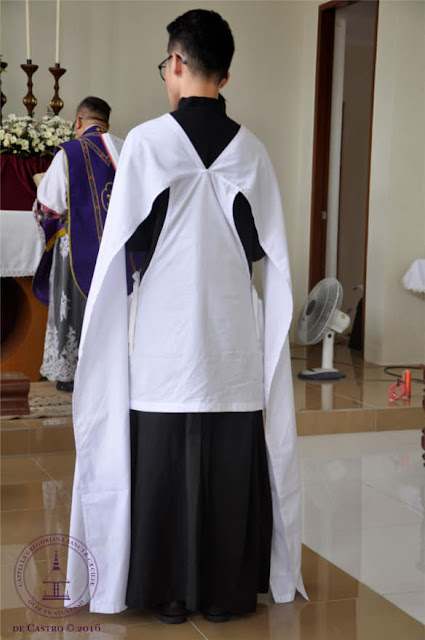 |
| Left: The so-called 'Venetian' surplice. Right a more typically Roman surplice. (As seen in San Simeon Piccolo, Venice) |
In the realm of vestments we have featured how there are different regional cuts that can be observed. While these are not hard and fast divisions, they represent trends particular to a region; sometimes they represent an older tradition that has been maintained in a particular region. The realm of the surplice is another such are of design where we can find some regional variations, most notably the so-called Venetian surplice and the Hispanic surplice (sometimes referred to as 'Mozarabic').
The Venetian surplice is essentially a form of winged surplice, something that can be found beyond the confines of Venice itself.  |
| A form winged surplice worn by St. Vincent de Paul |
The Venetian cotta is fairly similar, though shorter than your typical winged surplice -- much like most Italian forms of the surplice (or cotta). Here are two examples, taken from San Simeon Piccolo in Venice, showing this form of surplice:
Laid out flat, it looks something like this. While difficult to see, there are in fact sleeves to it (and as such, it is not a sleeveless surplice as you see used in places such as Lisbon, Portugal for instance). The sleeves are extremely wide, ending half way up the forearm. In terms of length, they are typically around halfway between one's belt and one's knees, give or take a few inches.
By comparison, here are some views of the sleeveless surplice that one can find worn in some places. It is very similar but not quite the same:
 |
| Lisbon, Portugal |
Finally, we conclude with a quick consideration of what some call a "Mozarabic" surplice, however, this is likely more properly considered a Hispanic surplice, not having any exclusive association to Toledo or the Mozarabic rite. This form of surplice has quite a unique configuration where the arms are concerned and can be found in former colonial territories even as far flung away as the Philippines.
 |
| St. Aloysius Gonzaga |



















